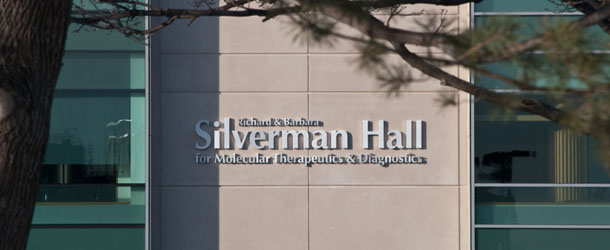Silverman Hall Takes Gold

Northwestern University’s newest science building, the Richard and Barbara Silverman Hall for Molecular Therapeutics and Diagnostics, is all about facilitating collaboration between scientists of different disciplines and their state-of-the-art laboratories. The building also is all about being green, now certifiably so.
A large underground cistern, chilled beams, a reflective roof, an automatic lighting system and the use of plenty of recycled and regional materials all contributed to the building receiving gold-level certification from the U.S. Green Building Council’s LEED (Leadership in Energy and Environmental Design) Green Building Rating System®.
Silverman Hall achieved points in all six areas of certification criteria: sustainable sites, water efficiency, energy and atmosphere, materials and resources, indoor environmental quality and innovation and design process.
The building is the third LEED-certified project at Northwestern. It joins the Ford Motor Company Engineering Design Building (LEED silver) and the School of Continuing Studies renovation at Wieboldt Hall (LEED gold). Northwestern has a policy of using environmentally sustainable design for its new buildings.
Silverman Hall, which houses 16 research groups from engineering and the physical and life sciences, was designed to enhance interactions and collaborations among colleagues and to be environmentally sustainable. The two are brought together by one of the building’s most striking features: the large number of windows in labs, common areas and outer walls, allowing people to connect with each other and the outdoors. The windows feature high-performance glazing that saves energy.
Visitors to Silverman Hall can learn about its green features by using the Green Touchscreen in the building’s lobby (http://northwestern.mtob.greentouchscreen.com/). The building features the first large cistern to be built on campus for irrigation. The underground cistern captures rainwater from the roof, which is used to irrigate landscaping for Silverman Hall and neighboring buildings.
Key energy-efficiency features include chilled beams installed in the ceiling to provide cooling, and fume hoods in the labs that use less air than typical hoods to exhaust fumes. (Based on the experience at Silverman Hall, a number of other campus buildings will be using chilled beams.) The roof of Silverman Hall is white and reflects sunlight, helping to reduce the urban heat island effect; lights automatically turn off when not in use; each lab station has its own task lighting; and the walls and roof are well insulated.
Of the total materials used for the project, more than 50 percent are regionally manufactured and more than 25 percent contain recycled content. (These materials do not include mechanical, electrical and plumbing systems.) Recycled content materials include structural steel, reinforcing bar and other metals, crushed concrete, drywall and composite wood. Regionally manufactured materials, made from raw materials harvested or extracted from within 500 miles of the building site, include concrete, demountable wall partitions, steel, drywall and crushed stone.
Zimmer Gunsul Fransca Partnership was the architect for Silverman Hall. HJKessler Associates, Inc., consultants in sustainable design, energy efficiency and high-performance buildings, was engaged during the design process to recommend specific measures that could be implemented to achieve LEED certification.
LEED, part of the U.S. Green Building Council, is an internationally recognized green building certification system, providing third-party verification that a building was designed and built using strategies aimed at improving performance across the metrics that matter most.
- Megan Fellman